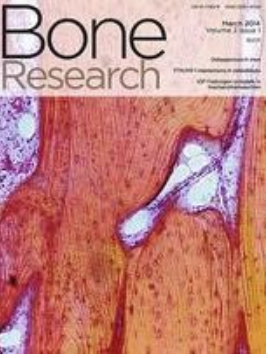损伤骨触发的骨因子分泌促进糖尿病伤口愈合。
IF 15
1区 医学
Q1 CELL & TISSUE ENGINEERING
引用次数: 0
摘要
严重糖尿病足的治疗仍然是一个临床挑战。虽然已经确定骨可以通过在其他器官分泌骨因子来发挥全身性作用,但这种内分泌功能是否可以被利用来促进糖尿病伤口愈合仍未研究。在这里,我们研究了骨损伤策略对糖尿病伤口愈合的影响,利用身体的先天再生能力刺激骨因子释放并影响远程皮肤伤口修复。本研究表明,胫骨缺损显著加速同侧糖尿病足皮肤创面愈合。在机制上,我们确定骨因子,血小板衍生生长因子- bb (PDGF-BB)是启动这一过程的关键。骨缺损触发PDGF-BB的大量释放,通过外周循环到达皮肤伤口部位。在皮肤伤口部位,PDGF-BB通过PDGFRβ信号通路介导成纤维细胞分泌角质细胞生长因子(KGF),从而通过旁分泌途径促进表皮细胞的快速再上皮化。此外,PDGF-BB水平升高可促进伤口内CD31hi Emcnhi血管的再生。重要的是,我们通过显示装载骨因子的胶原水凝胶促进糖尿病小鼠伤口愈合,证明了骨因子的治疗潜力。我们的研究结果揭示了骨和皮肤伤口愈合之间的明确联系,为难以局部治疗的慢性伤口提供了治疗灵感。本文章由计算机程序翻译,如有差异,请以英文原文为准。
Injured bone-triggered osteokines secretion promotes diabetic wound healing.
The treatment of severe diabetic foot remains a clinical challenge. While it is established that bone can exert systemic effects through the secretion of osteokines on other organs, whether this endocrine function can be harnessed to promote diabetic wound healing remains unexplored. Here, we investigate the impact of a bone injury strategy on diabetic wound healing, leveraging the body's innate regenerative capacity to stimulate osteokine release and influence remote skin wound repair. This study demonstrates that the tibial defect significantly accelerates ipsilateral diabetic foot skin wound healing. Mechanistically, we identify osteokines, platelet-derived growth factor-BB (PDGF-BB), as the key to initiating this process. Bone defect triggers a substantial release of PDGF-BB, which reaches the skin wound site via peripheral circulation. At the skin wound site, PDGF-BB mediates the secretion of keratinocyte growth factor (KGF) from fibroblasts via the PDGFRβ signaling pathway, thereby promoting the rapid re-epithelialization of epidermal cells through a paracrine pathway. Additionally, elevated PDGF-BB levels enhance the regeneration of CD31hi Emcnhi blood vessels within the wound. Importantly, we demonstrate the therapeutic potential of osteokines by showing that a collagen hydrogel loaded with osteokines promotes wound healing in diabetic mice. Our findings reveal a clear link between bone and skin wound healing, providing a therapeutic inspiration for chronic wounds that are difficult to treat locally.
求助全文
通过发布文献求助,成功后即可免费获取论文全文。
去求助
来源期刊

Bone Research
CELL & TISSUE ENGINEERING-
CiteScore
20.00
自引率
4.70%
发文量
289
审稿时长
20 weeks
期刊介绍:
Established in 2013, Bone Research is a newly-founded English-language periodical that centers on the basic and clinical facets of bone biology, pathophysiology, and regeneration. It is dedicated to championing key findings emerging from both basic investigations and clinical research concerning bone-related topics. The journal's objective is to globally disseminate research in bone-related physiology, pathology, diseases, and treatment, contributing to the advancement of knowledge in this field.
 求助内容:
求助内容: 应助结果提醒方式:
应助结果提醒方式:


